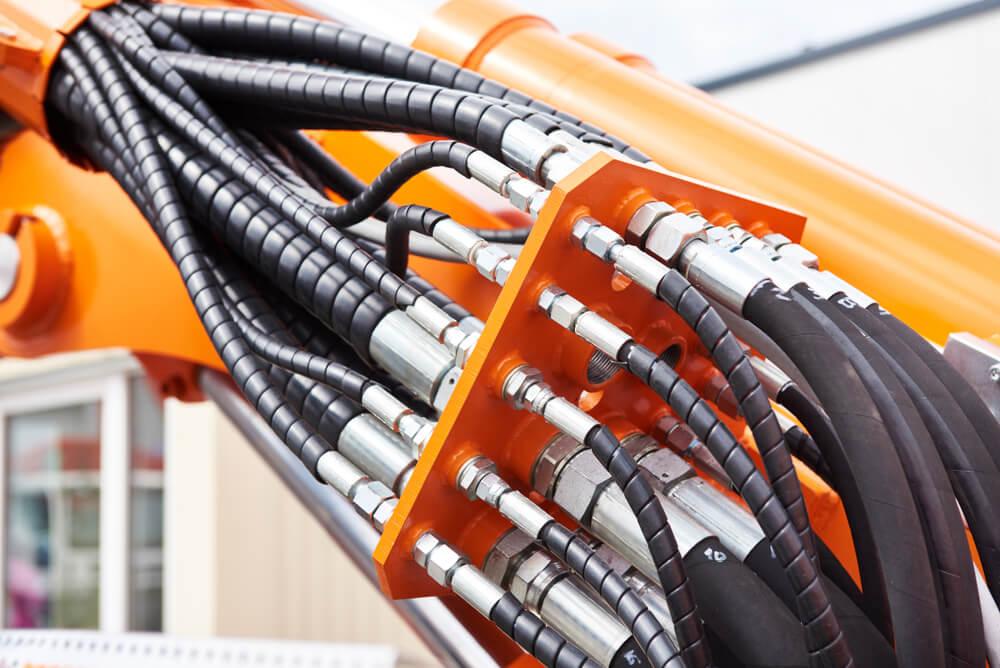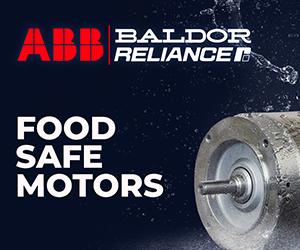You can find hydraulic fittings in almost every industry. They form secure, leak-proof connections between hoses, pipes, and other components in a hydraulic system. But with a wide range of types and sizes, navigating the world of hydraulic hose fittings can be tricky. This guide will equip you with the knowledge to choose, install, and connect these crucial components.
Table of Contents
- What Is a Hydraulic Fitting?
- Crimped Hydraulic Fittings & Field Attachable Fittings
- Hydraulic Hose Fitting Materials
- Types of Hydraulic Hose Fittings
- Hydraulic Hose Fitting Connections
- How to Select the Correct Hydraulic Hose Fitting
- How to Install Hydraulic Hose Fittings
- How to Maintain Hydraulic Hose Fittings
- Hydraulic Hose, Fitting, & System Experts
This comprehensive hydraulic hose fittings guide will help readers understand the different types of hydraulic hose fittings, their materials, and how to install and maintain them.
What Is a Hydraulic Fitting?


A hydraulic system uses the properties of pressurized fluid to move mechanical energy. The energy is transferred from one point to another using fluid inside hydraulic hoses, which are attached to machinery using hydraulic fittings.
Hydraulic fittings must attach securely to the equipment and hose and must withstand high pressure and temperatures. Fittings are made in different sizes, materials, types of seals, and temperature and pressure tolerances.
Some fittings enable fluid flow, others prevent it, and some are designed to do both. The most important function of a fitting is to create a tight seal that keeps fluid in and contaminants out.
Crimped Hydraulic Fittings & Field Attachable Fittings
Fittings can be attached to hoses either permanently or with a field connection.
Crimped Fittings
A permanently attached fitting is known as a crimped fitting. Crimped fittings are secured onto the hose with a crimping machine that crimps (bends) the fitting to ensure a resilient connection that is difficult to break.
Traditionally, all crimped fittings needed to be brought to a workbench to be attached to the hose, though with tool advancements, there are now portable crimpers that can be used in the field.
Hydraulic Couplers
A field-connection hydraulic fitting, also known as a hydraulic coupler, can be installed anywhere without a crimping tool and used multiple times. It is comprised of a socket and a nipple, and it allows for a blend of convenience and adaptability when immediate adjustments or replacements are required.
However, field connections are not generally recommended as they offer limited pressure capabilities and are often points of hose failure. We recommend using permanent crimped fittings on all hydraulic systems.
Hydraulic Hose Fitting Materials


Hydraulic hose fittings are manufactured using different materials, depending on the application and budget. Here are the most common hydraulic hose fitting materials and their characteristics:
- Steel Hydraulic Fittings: These fittings are made from steel and are impressively strong and durable.
- Carbon Steel: Non-stainless carbon steel can withstand extreme temperatures ranging from -63.4 degrees Fahrenheit to 500 degrees Fahrenheit (-53°C to 260°C). Non-stainless steel is not as corrosion-resistant as stainless steel is, though it is often more affordable.
- Stainless Steel Fittings: Stainless steel contains more complex alloys that offer a great range of material properties. Stainless steel fittings can be made to handle temperatures from -423.4 degrees Fahrenheit to 1198 degrees Fahrenheit (-253 °C up to 648 °C). Stainless steel fittings can be rated for up to 10,000 psi, and with special designs, they can withstand up to an incredible 20,000 psi. While stainless steel fittings offer the best strength and durability, they are also the most expensive.
- Brass Fittings: Brass hydraulic fittings are very popular for their excellent mix of corrosion resistance, durability, affordability, and strength. Brass has a temperature tolerance of -63.4 degrees Fahrenheit to 399 degrees Fahrenheit (-53°C to 204°C) and a pressure rating that peaks around 3,000 psi.
Choosing the right hydraulic fitting material for your application is important for a long-lasting, safe solution.
Types of Hydraulic Hose Fittings
There are many different types of hydraulic fittings. Different countries have different standards and types of fittings, though some machines and equipment may also favor one type over another.
Here are the main types of hydraulic hose fittings:
American Hydraulic Fittings Standards
- NPT (National Pipe Tapered): A time-tested standard using tapered threads for sealing. Available in various materials to handle different pressure needs. Size is determined by thread diameter minus 1/4 inch.
- NPTF (National Pipe Tapered Fuel): Popular for leak-proof connections in hydraulic systems. Tightening creates a metal-to-metal seal where the threads deform to create a permanent seal. Size is similar to NPT, measured by thread diameter minus 1/4 inch.
- NPSM (National Pipe Straight Mechanical): Utilizes straight threads with a 30° seat for sealing. If chamfered correctly, it is compatible with NPTF males.
- SAE Standards (Society of Automotive Engineers): A comprehensive range of fitting types like ORB, JIC, and ORFS, catering to diverse pressure and sealing requirements.
- ORB Fittings (O-Ring Boss): Ideal for high-pressure applications, these fittings use a straight thread and an O-ring for a secure seal.
- JIC Fittings (Joint Industry Council 37° Flare): A widely used fitting in hydraulics. Sealing is achieved by a 37° cone on the male part mating with the female’s flared tube.
- ORFS Fittings (O-Ring Face Seal): The go-to choice for superior leak prevention, especially in high-vibration environments. Features a flat sealing surface with an O-ring on the male part.
British & ISO Fitting Standards
- British Standard Pipe (BSP): Includes BSPT (tapered) and BSPP (parallel) threads. BSPT relies on thread deformation and sealants, while BSPP uses metal-to-metal contact or O-rings. Threads are marked with “G” for parallel or “R” for tapered to help with identification.
- ISO (Metric) Standards: Examples include ISO 6162 (4-bolt flange) and ISO 6149 (metric threads). Sealing is achieved using O-rings compressed into a chamfer, similar to SAE ORB.
German Fitting Standards
- DIN 7631: A common metric fitting with a 60° cone on the male part. Sealing occurs between the cone and the female’s tapered nose.
- DIN 3902: Offers various female connection options like compression and flareless swivel. The male part has a 24° angle, and some female options may include O-rings.
- DIN 3852: DIN 3852 fittings are a popular choice in hydraulic applications globally, setting a standard for connector and port designs. Their versatility makes them compatible with various hose sizes and metric threads.
Japanese Fitting Standards
- JIS Tapered Pipe (PT) and 30° Seat Connections: These are similar to BSP but designed for Japanese standards. They are interchangeable with BSPT fittings.
- JIS 4-Bolt Flange: This flanged head with grooves for O-rings and bolts provides a secure connection. It is available in standard and high-pressure series.
3 Hydraulic Hose Fitting Connection Types
There are three main types of hydraulic hose fitting connections:
- O-Ring Face Seal Fittings (ORF): As the name suggests, an O-ring is on the face of the fitting. When the side with the O-ring connects with the flat face of the female, a seal is formed. ORFS are ideal for high-pressure applications and can operate up to 6,000 psi. They are preferred because they are less likely to be over or under-tightened.
- Mated Angle Fittings: These fittings have thread, followed by an angled plane that creates a taper along the whole fitting, which is referred to as the “flare.” The threads do not form the seal; instead, when the male and female sides are threaded together, the flares meet up and create a seal. SAE 45° and JIC 37° are common examples of mated angle fittings. They rely on the wedge effect of the angled surfaces for a tight seal without requiring any additional sealants like O-rings. This makes them suitable for high-pressure applications (up to 9,000 psi).
- Tapered Thread Fittings: In a tapered thread fitting, the male has threads on the outside, while the female has threads on the inside. The threads deform when tightened to create a seal. This seal is prone to failure under high pressure and is frequently over-torqued, destroying its integrity. Tapered thread fittings aren’t used for high-pressure hydraulic and pneumatic systems, but they can be seen in low- to medium-pressure systems.
How to Select the Right Hydraulic Fitting
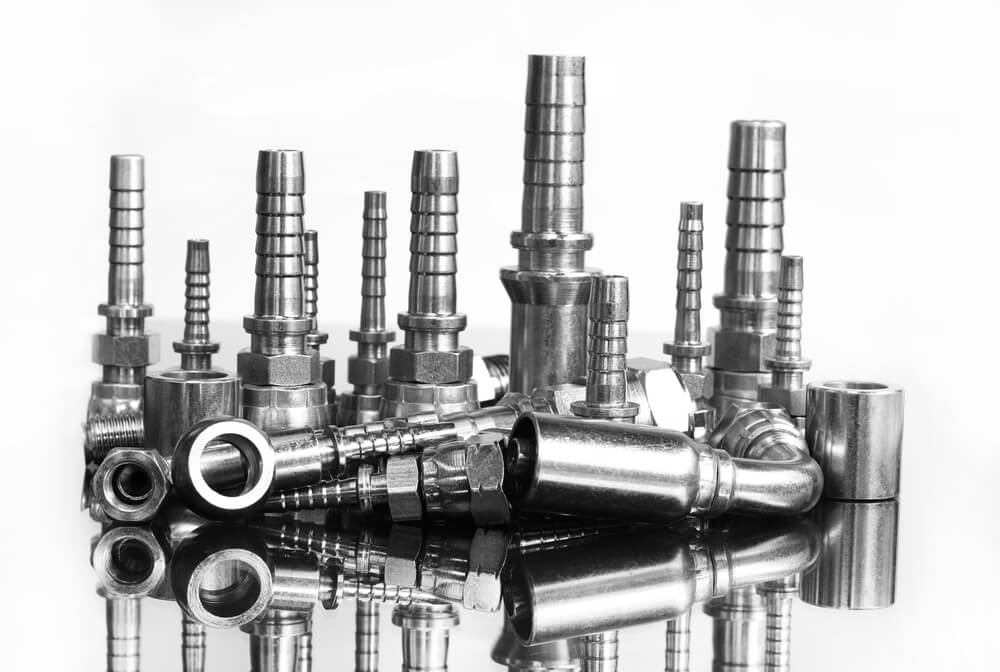

Choosing the right hydraulic fitting is crucial for a safe and efficient hydraulic system. Here’s a breakdown of the key factors to consider. Several of these considerations are summarized as a STAMP acronym:
- Size: This refers to the diameter and the thread type of the fitting. It should seamlessly match the hose or tubing you’re connecting. Common sizing standards include NPT, BSP, and metric (ISO), which are described above.
- Temperature: It is important to consider both the operating temperature of your system and the ambient temperature where the fitting will be used. Some materials may become brittle or lose strength at extreme temperatures.
- Application: Consider the fitting’s function within the system. Fittings designed to handle high-vibration environments may be required, while quick-connect options might be ideal for easy assembly and disassembly.
- Assembly: Related to the application, how will the fitting be attached to the hose or tubing? Crimped fittings are permanent and durable, while reusable fittings are more flexible.
- Material: The fitting material needs to be compatible with the hydraulic fluid being used and withstand the system’s pressure.
- Pressure: The fitting’s pressure rating must exceed the maximum pressure your hydraulic system will generate. Selecting a fitting below the system’s maximum pressure can lead to catastrophic failure.
- Fluid: Different fluids have varying properties, which may affect the choice of fitting material. The fluid must be compatible with the fitting material to avoid corrosion or degradation.
By carefully evaluating these factors, you can select the most appropriate hydraulic fitting for your application. If you have any doubts about the selection process, it is recommended that you consult a hydraulics professional–especially for complex systems.
Hydraulic Hose Fitting Installation & Maintenance Guide
The key to a long-lasting hydraulic hose system is proper installation and maintenance.
Installing a Hydraulic Hose Fitting
To ensure a leak-free, secure connection, you must pay careful attention to detail. Here are five steps to installing a hydraulic hose fitting:
1. Select the Appropriate Fitting
Choosing the appropriate fitting for the job requires considering the hose size, fitting type, connection type, and hydraulic system’s psi and temperature ratings. The fitting should be rated for more pressure and temperature than the hydraulic system’s rating to create room for a safety margin.
2. Cut & Prepare the Hose
The next step in crimping a hydraulic hose is to prepare it by cutting it to the required length. To ensure the hose is contaminate-free, make sure the cut is clean and straight and remove debris inside and outside of the cut end.
3. Crimp or Assemble the Fitting
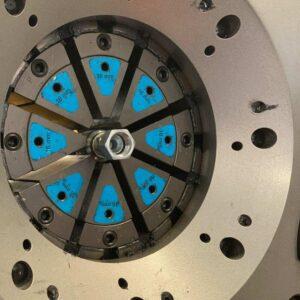

Follow the manufacturer’s instructions on crimping your fitting. You’ll need to choose the correct crimper diameter die set. Put the fitting all the way on the hose and secure the fitting at the insertion mark with a soft mallet.
Adjust your crimping machine’s settings to ensure the crimp is just right. Too tight or too loose, and the hose will fail. Set the hose on the machine so that the fitting sits just above the die and crimp it.
4. Conduct a Visual Inspection
After crimping the fittings, inspect the assembly to ensure everything is properly aligned. There should be no defects or irregularities.
5. Install Protective Caps & Test the Connection
After crimping the hose, use a protective plug to prevent contaminants from entering the hose or fittings. Then, a pressure test will be performed to check for leaks or other problems. Be sure to follow safety protocols, as testing under high pressure represents several safety concerns.
Hydraulic Fitting Maintenance
Just like any component, hydraulic fittings require regular maintenance. Here are some key hydraulic fitting maintenance practices to keep your fittings in top shape:
- Regular Inspections: Conduct visual inspections of your fittings at regular intervals, looking for signs of wear, corrosion, cracks, or loose connections. Pay close attention to areas around the threads and where the fitting connects to the hose or tubing.
- Cleaning: Dirt, debris, and contaminants can compromise the integrity of the seal and accelerate wear. Regularly clean your fittings using a mild soap solution and warm water. Avoid harsh chemicals or abrasive tools that might damage the fitting’s finish.
- Tightening: Over time, vibrations and pressure fluctuations can cause fittings to loosen slightly. Use a torque wrench to periodically check and tighten fittings to the manufacturer’s recommended specifications. Be careful–over-tightening can damage the threads or fitting body.
- Hose Condition: The health of the hose directly impacts the fittings. Regularly inspect hoses for signs of wear, damage, or bulging. Replace any compromised hoses and prevent them from putting undue stress on the fittings.
- Fluid Monitoring: Hydraulic fluid can degrade over time or even become contaminated. Maintain a regular fluid change schedule as recommended by your system’s manual. The fluid’s cleanliness plays a vital role in preventing corrosion and wear on fittings.
- Storage: When storing spare fittings, keep them in a clean, dry environment away from direct sunlight and extreme temperatures. This will help prevent corrosion and ensure they are ready for use when needed.
Visually inspect the fitting for damage, deformations, cracks, or corrosion. Replace the fitting if there are any signs of decay. Remove the O-ring and thoroughly clean the fitting, then replace the O-ring with a new one, regardless of how the old O-ring looks. Check that the threads run true and the fitting is ready to be reused!
Note that permanently crimped hydraulic hose fittings are designed for one use only and cannot be reused.
Hydraulic Hose Experts
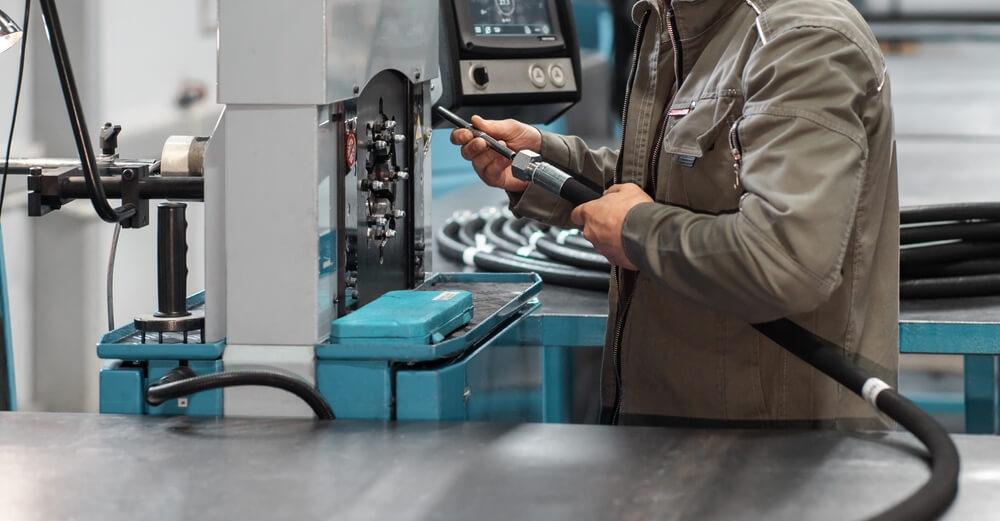

Need help with your hydraulic fittings? IBT’s expert Hydraulic Division is ready to assist you. Whether you need to know which fitting works best for your application or a full hydraulic system design, our professionals will walk you through the best solutions.
With over a million dollars in industrial hose and fitting inventory, we have all the parts you need. Browse our hydraulic fittings from our ShopIBT store.
Our Kansas City Industrial Hose Shop also provides everything from simple repairs to fully assembled hydraulic systems.
We also offer Hydraulic Systems 101 Academy Safety, Maintenance, and Troubleshooting classes to train your technicians.
Contact us to learn more about our hydraulic systems and fittings services and products.

